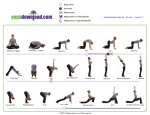
Setu Bandha Sarvangasana (bridge pose) is a go to pose that can help solve any number of problems. From developing strength in your core and glutes (which helps alleviate low back pain) to opening the chest, bridge pose is a must if you don’t already incorporate it into your practice. There are so many variations, it’s accessible by nearly everyone.
What’s in a name?
If we break down the Sanskrit name for bridge pose, Setu Bandha Sarvangasana; Setu means bridge or dam, Bandha meaning lock. And the meaning of Sarvanga is support. The Bandha or ‘lock’ in this pose is at the throat, is Jalandhara, the throat energy valve. Bridge pose involves bringing the chest up to the chin and extending the upper thoracic at the same time. In addition to the physical benefits of this lock including stimulating the thyroid, Jalandhara connects the head with the heart by opening the throat chakra, helping us establish balance between body and mind, and enabling us to live our truth.
What are the benefits of bridge pose?
- There are a number of ways bridge pose can help us develop strength or alleviate ailments including:
- Toning the butt (when glutes are active)
- Teaches inactive glutes to fire
- Strengthens spinal muscles
- Strengthens hamstrings
- Enhances digestive system and stimulates abdominal organs.
- Provides relief for menopausal symptoms.
- Builds pelvic floor strength
- Improves circulation
- Strengthens low back by developing core stability
- Stimulates thyroid

- Opens lungs for better breathing
- Opens heart & throat chakras
Who should not do bridge pose?
Anyone with neck or knee injuries or issues should avoid bridge pose. However, if you have issues with your knees, you may be able to do supported bridge with. Also, women who are menstruating should avoid inversions, of which bridge pose is one, although supported bridge will help alleviate menstrual discomfort. Pregnant women should avoid inversions or lying on their back for too long. Once you hit the second trimester, the increased weight of your uterus while lying on your back interferes with the flow of blood and nutrients to your developing baby.
Getting into bridge pose
From lying on your back (supine), bend your knees at ninety degrees and place your feet flat on the floor, hip width apart and parallel. You may choose to have a folded blanked under your shoulders to support your neck. I start with the knees at a ninety degree angle to see if there are any sensitivities. Eventually you’ll want to move your heals closer to your buttocks.
Arms are by your sides with your palms facing down. As you exhale, press your inner feet and arms actively into the floor, and your pelvis up toward the ceiling. Firm and lift the buttocks off the floor. Be sure to keep your legs parallel and not let your knees splay apart.
To take the pose deeper, you can roll your shoulders and chest open, and clasp your hands under your pelvis and extend through the arms to help you stay on the tops of your shoulders.
Lift your buttocks until the thighs are about parallel to the floor. Keep your knees directly over the heels, but push them forward, away from the hips, and lengthen the tailbone toward the backs of the knees. Lift the pubis toward the navel.
Don’t move your head from side to side, but gently lift your chin way from the sternum slightly and open your chest by pressing the shoulder blades into the floor. This will allow you to press the top of the sternum toward the chin. Keep firming the outer arms, broadening the shoulder blades, and lifting the chest.
Hold the pose for 30 seconds or a minute if you can, and release with an exhale, rolling the spine one vertebrae at a time onto the floor.
Bridge pose variations
 If you want to take your bridge pose to the next level, you can try Eka Pada Setu Bandha Sarvangasana one one-legged bridge pose.
If you want to take your bridge pose to the next level, you can try Eka Pada Setu Bandha Sarvangasana one one-legged bridge pose.
Supported bridge pose using a block and a strap allows you to relax in the pose for an extended period of time. For supported bridge, place a strap around your thighs to keep the knees from falling open, and a block under your sacrum to rest your weight on. One of my students has called this version of the pose, “delicious.”
In what I call an ‘alignment variation’ you can use blocks to become familiar with proper alignment for your legs and feet.
To prevent your legs from turning out when you come into the pose, place a block flat on the floor between your feet (in whichever position keeps them hip-distance apart) and keep the inner edges of your feet alongside the block as you come into the pose.
Place a second block between your inner thighs (in whatever position keeps your knees hip-distance apart) and squeeze the block with your legs enough to keep the block in place as you exhale into the pose.
In a coming post, I’ll talk about what it means when your glutes aren’t firing, and bridge pose is critical to helping your body relearn what it’s forgotten.
Happy bridging!
Namaste.
– Your Charmed Yogi
(Photos: Yoga iSport, Prevention, Do Restorative Yoga)
Related posts:













 If you want to take your bridge pose to the next level, you can try Eka Pada Setu Bandha Sarvangasana one one-legged bridge pose.
If you want to take your bridge pose to the next level, you can try Eka Pada Setu Bandha Sarvangasana one one-legged bridge pose.








